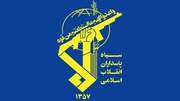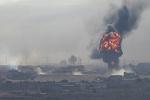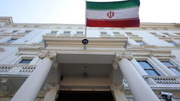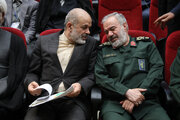If it were proposed that this fraction of the tax revenues should be allocated to reduce the pains in the hearts of one thousand owners of foreclosed properties in the working class neighborhoods of Chicago or to improve the educational quality of the pathetic school systems in the South Bronx, Bed Stuyvesant of Brooklyn or Spanish Harlem, to cite just a few examples, no doubt the same senators who enthusiastically and unanimously voted for the bill would have rejected it outright with no hesitation or mercy. The prevailing political climate in the United States shows the nature and quality of the so-called democratic principals, drilled daily into the heads of the masses by the media, and also the non-existent influence of the working class on the governing institutions of the land.
What was the rush that the U.S. military, amid the country’s financial and economic crisis, had to speed up the deployment of a most powerful and therefore expensive system, called AN/TPY-2 forward-based X-band, a year earlier than it was scheduled previously? The X-band system, deployed to Israel on September 26th, was originally scheduled for delivery in 2009 for joint training exercises, according to the U.S. European Command mission (EUCOM). For reasons not explained by the U.S. Senate Intelligence Committee, the ownership of Army/Navy Transportable Radar Surveillance remains with Washington and the system will be installed and operated permanently by 120 U.S. military personnel drawn from U.S. units stationed in Germany and across the rest of Europe.
The well-concealed secret of this rush delivery of the X-band radar system lies in the fact that the U.S. has finally come to the realization that with two active wars in Iraq and Afghanistan at hand and an explosive situation in Pakistan, with a population of 170 million and a nuclear arsenal, not to mention the ever-deepening financial and economic stranglehold gripping not only the housing but also the banking and industrial sectors of the Western capitalist economies, it must, though unwillingly, resign itself to a situation where it has to take other options off the table and begin a dialogue with an ever-stronger and more confident Iran.
It is also common knowledge that the U.S. is quietly opening up to Iran, which has become a huge source of anxiety for the Zionist ringleaders in Tel Aviv, who, like egotistical servants, feel abandoned by their masters in Washington or cheaply sold for the benefit of the U.S. empire. The delivery of an important element of the U.S. Ballistic Missile Defense Shield to Israel a year earlier plays the role of relaxing and calming down the sense of anxiety and desperation with regard to the current U.S.-Iran dialogue and could be regarded as compensation for Israel’s loss of its junior role in shaping U.S. foreign policy in the Middle East region.
The radar system is to be installed at Israel’s Nevatim Air Base in the Negev Desert in the south of the country, making it the first time that U.S. Army personnel will be permanently stationed in Israel. The type of X-band radar proposed by the U.S. Army works on the same wavelength as a microwave oven. Its tremendous power gives it impressive precision and velocity. It can locate an object the size of a baseball 2,900 miles (4,700 kilometers) away. The X-based radar is designed to track ballistic missile warheads moving through space and provide ground-based missiles with the data needed to intercept them. But serious concerns have been raised for the safety of the communities living near the radar. For example in the Czech Republic, where a similar type of radar is planned to be installed, 60 percent of the population remains opposed to the U.S. project, many due to public health concerns.
According to the Sydney Morning Herald, the radar would serve not only Israel but also the U.S. military forces in the hemisphere. The radar will be integrated with both the Israeli and the U.S. ballistic missile defense networks. It would be prudent for U.S. citizens to be aware that prior to the $89 million U.S. gift of radar to Israel, stratfor.com wrote: “The now-operational Israeli Arrow Ballistic Missile System (BMD) in all likelihood would not have been possible without U.S. assistance and aid.”
On one hand, the link between Israel’s currently operational Arrow Missiles through the medium of the X-band radar with the U.S. offensive and defensive missile system suggests a broad integration of missile defense shields of the two countries. On the other hand, the fact that the U.S. deployed the new radar in separate parts and under the radar shows that the U.S. gave lip-service to Iran, trying to avoid antagonizing it at a sensitive time.
As to the needs, uses, and introduction of such radar systems into the Middle East, various scenarios have already been advanced by U.S. and Israeli sources, some of which are misleading. For example, one story asserts that the installation of the radar system, with the permanent presence of its U.S. crews, is intended to restrain Israel from any untoward adventurism. The converse scenario, mostly sponsored by pro-Zionist mouthpieces, tries to argue that the system is intended to strengthen Israel’s defensive capabilities. The last and most plausible scenario is that the U.S. intends to add one more strategic military base to the hundreds it operates around the world to contain and intimidate independent countries like Iran, Syria, and Lebanon.
An underground strategic air command post is reportedly located at Nevatim Air Base. Located southeast of Beersheba on the edge of the Negev, this facility was originally built in 1947 as a landing strip known as Malhata. In September 1978, Israeli and Egyptian negotiators met with U.S. President Jimmy Carter at Camp David to negotiate the terms of peace. An agreement was signed in March of 1979 which called for the phased withdrawal of all Israeli troops from the Sinai by 1982. The Camp David Accords were matched by U.S. pledges for security assistance for both Israel and Egypt totaling nearly $3 billion. A new air base, planned and built by Israel with U.S. funding opened in October 1983 with two runways 3,050 meters and 2,440 meters in length. Three of the IDF’s key air bases -- Ramat David, Tel Nof and Nevatim -- are all located close to the pre-1967 cease-fire line, known as the Green Line.
In July 1998 it was reported that Turkish warplanes are based at Nevatim on a regular basis as part of an agreement between Turkey and Israel. In return, Israeli jets are based in Turkey. The Elrom Company has prepared a study examining the possibility of establishing a second international airport for Israel at Nevatim. An unusual coalition of mayors and citizens of the Dan Metropolitan area and the Negev has been formed to lobby for developing Nevatim.
Dozens of F-16 fighter jets, originating from a base in the south of the country, landed on March 31, 2003 at the Nevatim Air Force base. A ceremony for the transfer of the squadron was held, with the commander of the Israeli Air Force, Major General Dan Halutz, in attendance. The new squadron will be known as the Flying Wing. A decade earlier, the IDF chain of command raised the question of whether or not to close the base at Nevatim as a result of budgetary woes. However, with the reception of the new squadron and additional changes in the offing, Nevatim has been transformed into one of the largest bases in the country.
In June 2003, an additional squadron of F-16’s arrived at the base, and plans have been made to receive transport planes. F-16’s were introduced to the Israeli Air Force in 1980, and serve as the backbone of the IAF. A year after their arrival, the planes were deployed to bomb the Iraqi nuclear reactor. Several of the planes that were moved participated in the attack.
(Oct. 15 Tehran Times Opinion Column, by Ardeshir Ommani)
PA/HG
END
MNA

























Your Comment